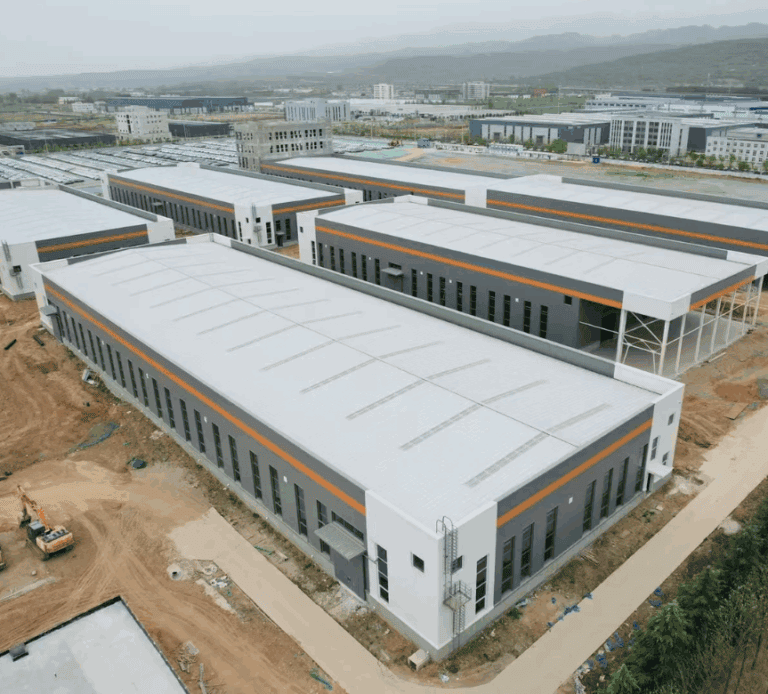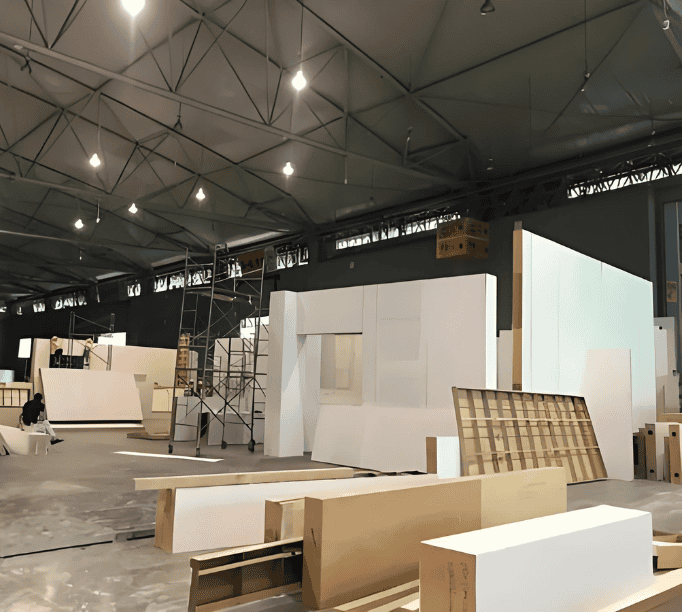Modulhäuser sind keine Mobilheime – und sie sind auch keine bloße Budgetersparnis. Aber wenn man sie mit traditionellen Holzhäusern vergleicht, fühlt man sich schnell ratlos. Ist schneller wirklich besser? Bedeutet ein niedrigerer Preis auch eine geringere Qualität? Bleibt der Wert langfristig erhalten?
Dieser Leitfaden räumt mit der Verwirrung auf. Wir erklären Ihnen, wie die einzelnen Optionen funktionieren, wo sie sich unterscheiden und wie sich diese Unterschiede auf Ihr Budget, Ihren Zeitplan, Ihre Gestaltungsfreiheit und Ihren langfristigen Wert auswirken. Kein Schnickschnack. Kein Fachjargon. Nur klare Antworten, die Ihnen helfen, intelligenter und selbstbewusster voranzukommen.
Was wird in diesem Blog erwartet:
Was ist der wirkliche Unterschied zwischen Fertighäusern und Häusern in Holzrahmenbauweise?
Wenn Sie sich zwischen einem Fertighaus und einem Holzhaus entscheiden müssen, ist es wichtig zu verstehen, wie diese gebaut werden und was das für Sie bedeutet.
Beginnen wir mit den Grundlagen.
A Holzhaus wird komplett vor Ort errichtet, Stück für Stück, beginnend mit dem Fundament. Dies ist die traditionelle Art des Hausbaus und wahrscheinlich das, was Sie sich unter „individuellem Hausbau“ vorstellen. Jeder Teil des Prozesses – Rahmenbau, Dachdeckerarbeiten, Klempnerarbeiten, Elektroarbeiten – findet auf Ihrem Grundstück statt.
A modulares Hauswird dagegen in einer Fabrik in Abschnitten gebaut. Diese Abschnitte, auch „Module“ genannt, werden dann zu Ihrem Standort transportiert und auf einem festen Fundament montiert – genau wie ein Fertighaus. Nach der Fertigstellung unterscheidet sich ein Fertighaus optisch und funktional nicht von einem herkömmlichen Haus.
Der Hauptunterschied besteht also darin, Wo das Haus ist gebaut – nicht Was es ist.
Beide Haustypen erfüllen die örtlichen und staatlichen Bauvorschriften, einschließlich des International Residential Code (IRC). Und beide können für langfristiges Wohnen konzipiert werden, nicht nur für die vorübergehende Nutzung.
Dieser Standortwechsel – von der offenen Baustelle zur kontrollierten Fabrik – wirkt sich jedoch auf viele Dinge aus: Bauzeit, Kostenkontrolle, Qualität und wetterbedingte Verzögerungen (auf die wir in den nächsten Abschnitten eingehen).
Wenn Sie denken, „Wird sich ein Fertighaus anders anfühlen?“– lautet die Antwort nein. Nach der Installation und Fertigstellung ist ein Fertighaus selbst für Profis kaum von einem Fertighaus zu unterscheiden.
Welcher Haustyp ist günstiger? Modular oder in Holzrahmenbauweise?
Seien wir ehrlich – die Kosten spielen eine Rolle. Und wenn Sie gehört haben, dass Fertighäuser günstiger sind als Häuser in Holzrahmenbauweise, liegen Sie damit richtig. Die eigentliche Frage ist jedoch: Warum?
Es geht nicht nur um den endgültigen Preis. Es geht darum, wie der Preis zustande kommt.
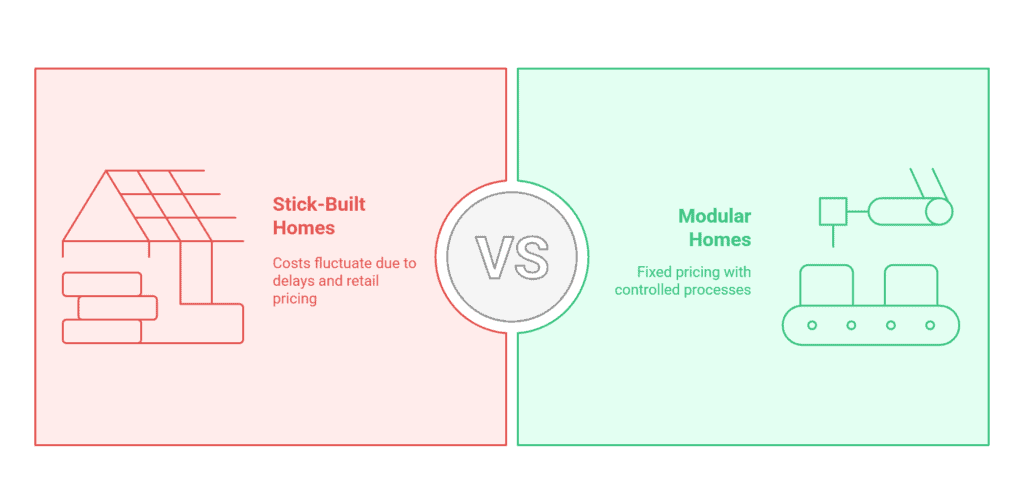
Häuser in Holzrahmenbauweise: Preisgestaltung nach Verbrauch
Beim Bau eines Holzhauses summieren sich die Kosten im Laufe des Prozesses. Materialien werden in kleinen Mengen von lokalen Lieferanten gekauft, oft zu Einzelhandelspreisen. Die Arbeitseinsätze werden täglich geplant, und Verzögerungen – beispielsweise durch schlechtes Wetter oder Konflikte mit Subunternehmern – können den Zeitplan verlängern und die Kosten in die Höhe treiben.
Schlimmer noch: Bei vielen Baustellenprojekten kommt es zu Änderungsaufträgen oder unerwarteten Kostenüberschreitungen. Das bedeutet, dass Ihr ursprüngliches Budget oft nicht Ihr endgültiges ist.
Fertighäuser: Festpreis, kontrollierter Prozess
Bei modularen Häusern erfolgt der Großteil des Baus in einer Fabrik – nach einem festgelegten Zeitplan und unter Verwendung von vorab gekauften Materialien in großen Mengen. Das bedeutet, dass Hersteller Ihnen eine Festpreis bevor das Haus überhaupt bei Ihnen eintrifft.
Sie zahlen nicht für Verzögerungen, Materialverschwendung oder unvorhersehbare Arbeitskosten. Sobald Ihr Vertrag unterzeichnet ist, sind Ihre Kosten festgeschrieben. Dieses Maß an Sicherheit ist bei herkömmlichen Bauweisen schwer zu finden.
Ist Modular also immer günstiger?
Nicht immer – aber oft. Besonders wenn man Folgendes berücksichtigt:
- Schnellere Bauzeit (geringere Transportkosten)
- Weniger Verzögerungen
- Weniger Abfall
- Geringeres Arbeitsrisiko
- Genauere Budgetierung
Kurz gesagt, Fertighäuser sind oft mehr Wert liefern für Ihre Investition – nicht nur eine niedrigere Zahl.
Wie lange dauert der Bau der einzelnen Haustypen?
Wenn Sie Ihren Umzug planen, ist der Zeitplan wichtig. Sie möchten wahrscheinlich nicht Monate oder sogar Jahre damit verbringen, auf den Einzug in Ihr neues Zuhause zu warten.
Wie lange dauert es also tatsächlich?
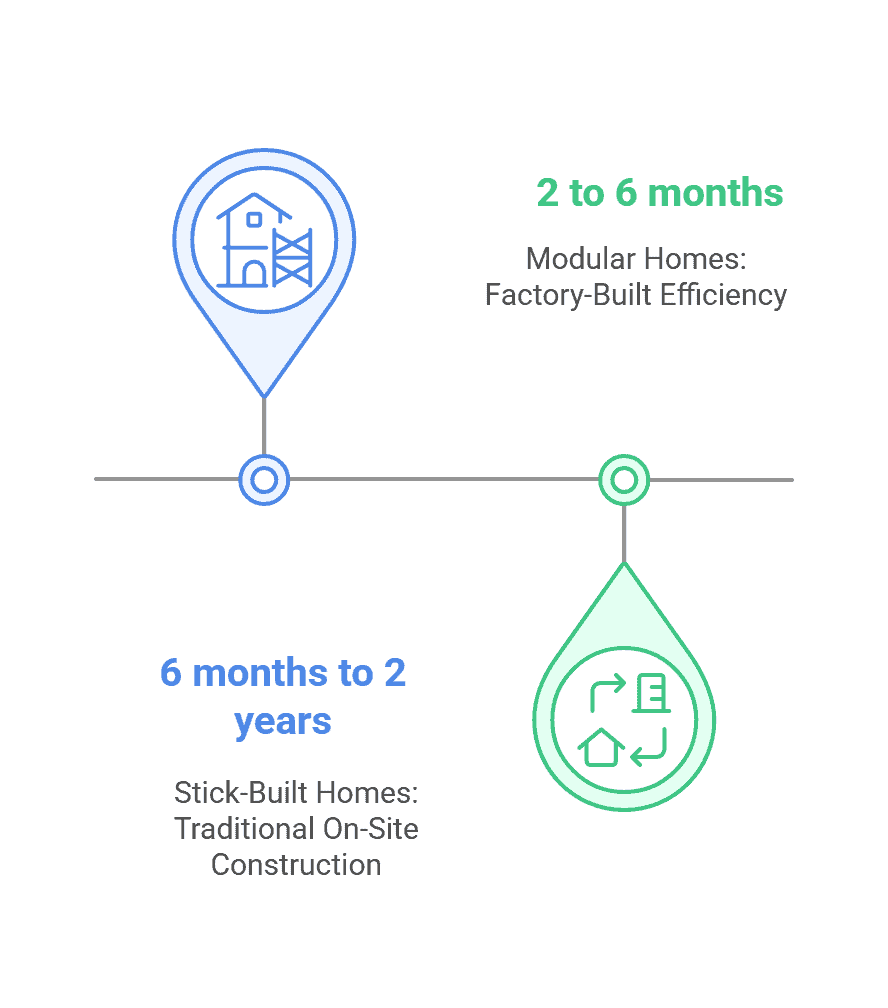
Holzhäuser: Ein langer, wetterabhängiger Prozess
Traditionelle Häuser werden vor Ort Schritt für Schritt gebaut. Dieser Prozess kann dauern 6 Monate bis 2 Jahre, abhängig von Standort, Wetter, Zeitplänen der Auftragnehmer und Materialverfügbarkeit. Und wenn etwas schief geht – eine Verzögerung bei den Genehmigungen, eine Regenzeit, ein Mangel an Arbeitskräften – summiert sich das alles.
Es gibt kein garantiertes Enddatum, bis die Arbeit erledigt ist.
Fertighäuser: Bauzeit verkürzt, mehr Kontrolle
Fertighäuser werden außerhalb der Baustelle in einer Fabrik gebaut, während das Fundament vorbereitet wird. Dieser parallele Prozess spart Wochen – oder sogar Monate.
Die meisten Fertighäuser sind innerhalb von 2 bis 6 MonateSobald die Module eintreffen, kann das Haus innerhalb weniger Tage auf das Fundament gestellt werden. Der Innenausbau erfolgt schnell.
Der schnellere Build bedeutet nicht eine geringere Qualität. Er bedeutet weniger Verzögerungen, eine bessere Planung und eine kontrolliertere Umgebung.
Warum das für Sie wichtig ist
Eine kürzere Bauzeit spart nicht nur Zeit. Sie spart:
- Zusätzliche Miet- oder Hypothekenzahlungen
- Belastungen durch langjährige Bauzeit
- Risiko steigender Material- oder Arbeitskosten
Sie kommen schneller in Ihr neues Zuhause – und erleben unterwegs weniger Überraschungen.
Gibt es einen Qualitätsunterschied zwischen Fertighäusern und Häusern in Holzrahmenbauweise?
Das ist eine berechtigte Frage: Wenn ein Fertighaus schneller gebaut wird und weniger kostet, bedeutet das dann, dass es auch von geringerer Qualität ist?
Überhaupt nicht. Tatsächlich erfüllen viele Fertighäuser die gleichen Standards wie herkömmliche, vor Ort gebaute Häuser – oder übertreffen diese sogar.
Sowohl Fertighäuser als auch Häuser in Holzrahmenbauweise unterliegen denselben Bauvorschriften, wie dem International Residential Code (IRC) und dem National Electrical Code (NEC). Der Unterschied liegt nicht in den Standards, sondern in der Art und Weise, wie diese Standards erreicht werden.
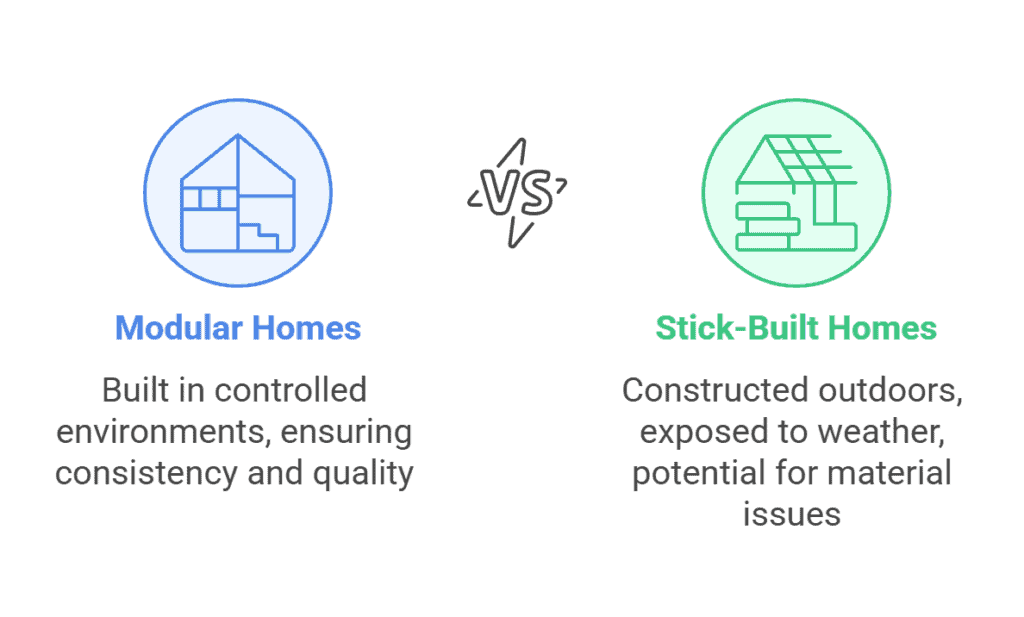
Häuser in Holzrahmenbauweise werden im Freien errichtet und sind oft wechselnden Wetterbedingungen ausgesetzt. Materialien wie Holz und Isolierung können während der Bauphase Regen oder Schnee ausgesetzt sein, was das Risiko von Verformungen, Schimmel oder Unregelmäßigkeiten erhöht.
Modulare Häuser werden in geschlossenen Räumen in einer kontrollierten Fabrikumgebung hergestellt. Die Materialien werden trocken gehalten, die Ausrüstung ist präzise, und qualifizierte Mitarbeiter führen jedes Mal die gleichen Schritte aus. Diese Fabriken verwenden Vorrichtungen, automatisierte Werkzeuge und Qualitätskontrollen in jeder Phase, um konsistente Ergebnisse zu gewährleisten.
Darüber hinaus werden Fertighäuser während des gesamten Bauprozesses – nicht nur am Ende – von lizenzierten Drittagenturen geprüft. Das bedeutet, dass die Qualität mehrfach überprüft wird, bevor Ihr Haus das Werk verlässt.
Die Bauweise ist zwar anders, das Ergebnis jedoch nicht. Ein Fertighaus ist keine abgekürzte Version eines echten Hauses – es Ist ein echtes Haus, anders gebaut, mit Blick auf Effizienz und Konsistenz.
Können Sie ein Fertighaus wie ein Holzrahmenhaus individuell gestalten?
Einer der größten Mythen über Fertighäuser ist, dass sie nicht individuell anpassbar sind. Die meisten Menschen stellen sich einen Katalog mit festen Grundrissen vor, in dem kein Raum für persönlichen Stil oder individuelle Bedürfnisse bleibt.
Aber so funktioniert es nicht.
Die Wahrheit ist, modulare Häuser dürfen individuell angepasst werden – manchmal genauso individuell wie ein traditionelles Holzhaus. Der Schlüssel liegt darin, zu verstehen, wie modulares Design funktioniert.
Jedes Haus wird in „Modulen“ oder Abschnitten gebaut, die so konzipiert sind, dass sie vor Ort zusammenpassen. Solange Ihr Grundriss in Module unterteilt werden kann, kann er umgesetzt werden. Sie wünschen sich eine offene Küche mit Kochinsel? Kein Problem. Eine Master-Suite mit gewölbten Decken und begehbarem Kleiderschrank? Auch das ist machbar.
Viele Fertighausbauer arbeiten eng mit Ihnen zusammen, um Grundrisse anzupassen, Oberflächen auszuwählen und die Raumaufteilung zu optimieren. Von Arbeitsplatten über Fensterstile und Bodenbeläge bis hin zu Schrankfarben – Sie haben die Wahl, wie Ihr Haus zu Ihrem eigenen wird.
Natürlich gibt es strukturelle Grenzen. Sie können keine tragende Wand verschieben oder etwas anfordern, das sich nicht gut transportieren lässt. Für die meisten Hausbesitzer ist die Auswahl an Gestaltungsmöglichkeiten jedoch mehr als ausreichend.
Wenn Sie sich also Ihr Traumhaus vorstellen und sich fragen, ob modulare Lösungen möglich sind, dann ist es wahrscheinlich möglich. Der beste Weg, das herauszufinden? Sprechen Sie mit einem Bauunternehmer, der weiß, wie man modulare Lösungen passend macht. Du.
Steigt der Wert von Fertighäusern genauso wie bei herkömmlichen Häusern?
Diese Frage wird häufig gestellt – und sie ist wichtig. Behält ein Fertighaus seinen Wert im Laufe der Zeit? Wird es im gleichen Maße an Wert gewinnen wie ein Fertighaus?
Die kurze Antwort lautet: ja, das kann es.
Modulhäuser werden nach den gleichen Bauvorschriften wie Massivhäuser gebaut und auf einem festen Fundament errichtet. Nach der Installation werden sie rechtlich und physisch wie herkömmliche Häuser behandelt – nicht wie Mobilheime oder Fertighäuser. Das bedeutet, dass Gutachter, Kreditgeber und Immobilienmakler sie nach den gleichen Kriterien bewerten wie jedes andere Haus.
Allerdings ist eine Wertsteigerung nie garantiert – egal, wie Ihr Haus gebaut ist. Zu den tatsächlichen Faktoren, die den Hauswert beeinflussen, gehören:
- Lage und Nachbarschaft
- Lokale Markttrends
- Grundstückseigentum und Grundstückswert
- Der Zustand und die Ausstattung des Hauses im Laufe der Zeit
In diesem Zusammenhang kann der Wert eines gut gepflegten Fertighauses in einem Wachstumsgebiet durchaus steigen – genau wie bei einem vor Ort gebauten Haus.
Der Schlüssel liegt darin, langfristig zu denken. Ein Fertighaus bietet Ihnen das gleiche Potenzial für Wertsteigerung und Wiederverkauf –solange die Fundamentaldaten stark sind. Bauen Sie es richtig, pflegen Sie es gut und platzieren Sie es am richtigen Ort – und es wird Sie belohnen.
Gibt es bei Fertighäusern Probleme mit der Zoneneinteilung oder Genehmigung?
Dies ist eines der häufigsten Probleme – und eines der am einfachsten zu lösenden.
Wie wir im vorherigen Abschnitt erklärt haben, sind modulare Häuser rechtliche, dauerhafte StrukturenSie werden nach den gleichen Wohnvorschriften wie Fertighäuser gebaut und unterscheiden sich von Fertighäusern oder Mobilheimen. Sobald ein Fertighaus auf einem Fundament steht, wird es von den lokalen Behörden wie jeder andere Neubau behandelt.
Dennoch variieren die Bauvorschriften je nach Stadt, Landkreis und Bundesland. In manchen Gebieten gelten möglicherweise Gestaltungsanforderungen, Zonenvorschriften oder Erscheinungsbildstandards für alle Häuser – auch für Fertighäuser. Deshalb ist es wichtig, mit einem Bauunternehmer zusammenzuarbeiten, der die örtlichen Gegebenheiten kennt und Sie bei der Orientierung unterstützt.
Wenn Sie sich nicht sicher sind, ob Ihr Grundstück für ein Fertighaus geeignet ist, fragen Sie am besten zunächst nach. Ein seriöser Fertighausbauer kann in der Regel Ihre Zonen- und Genehmigungsanforderungen für Sie prüfen oder Sie an die richtigen Stellen verweisen.
Fazit: Sie sind nicht allein. Und wenn Sie mit dem richtigen Team zusammenarbeiten, sollten Genehmigungen kein Hindernis darstellen.
Ist ein Fertighaus das Richtige für Sie?
An diesem Punkt haben Sie gesehen, wie modulare und Holzhäuser im Vergleich abschneiden – aber die eigentliche Frage ist: was brauchst du am meisten?
Sie wünschen sich einen schnelleren Einzugstermin mit weniger Baustress?
Sie arbeiten mit einem festen Budget und suchen nach Kostensicherheit?
Ist Ihnen Qualität wichtig, aber Sie haben kein Interesse an endlosen Verzögerungen auf der Website?
Wenn Ihnen das bekannt vorkommt, könnte ein Fertighaus genau das sein, wonach Sie gesucht haben.
Es geht nicht nur darum, wie das Haus gebaut wird – es geht darum, wie reibungslos der Prozess in Ihr Leben passt. Fertighäuser bieten Ihnen die Möglichkeit, Ihr Wunschhaus zu bekommen, ohne dabei Zeit, Geld oder Nerven zu verlieren.
Immer noch unsicher? Das ist völlig normal. Am besten besprechen Sie Ihre Möglichkeiten mit einem Bauunternehmer, der beide Seiten versteht und Ihnen bei der Entscheidung helfen kann, was für Sie das Richtige ist.
Lassen Sie uns darüber sprechen, was möglich ist
Wenn Sie denken, dass ein modulares Haus das Richtige für Sie sein könnte, aber noch Fragen haben, sind Sie nicht allein. Ein Haus zu bauen ist eine große Entscheidung. Wir sind hier, um es Ihnen leichter zu machen.
Bei SteelPRO PEB kombinieren wir Full-Service-Design mit fortschrittlicher Stahlkonstruktionsfertigung, um Ihre Vision schnell, sicher und ohne Rätselraten zum Leben zu erwecken. Sie erhalten:
- Kostenlose 2D- und 3D-Designpläne nach Maß
- Stahlkomponenten direkt ab Werk, Lieferung mit Schutzverpackung und sichtbarer Produktionsverfolgung
- Schritt-für-Schritt-Installationsunterstützung – von Videoanleitungen bis hin zu Remote-Walkthroughs
- Expertengespräche vom ersten Tag an – Ingenieure, nicht nur Verkäufer
Kein Druck, keine komplizierten Schritte. Nur ein klares, ehrliches Gespräch darüber, was für Ihr Grundstück, Ihr Budget und Ihren Zeitplan am besten geeignet ist.
Erzählen Sie uns, was Sie planen – und wir zeigen Ihnen, wie Sie es verwirklichen können.
[Starten Sie Ihre Projektberatung →]
